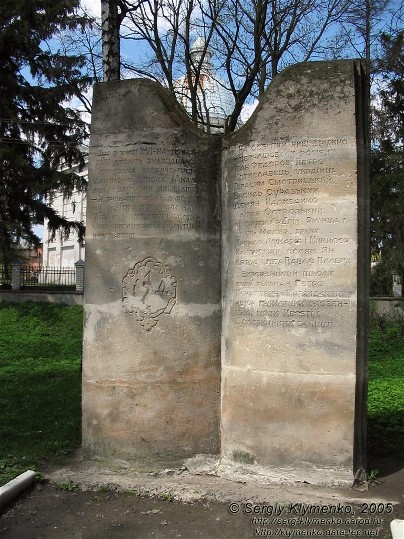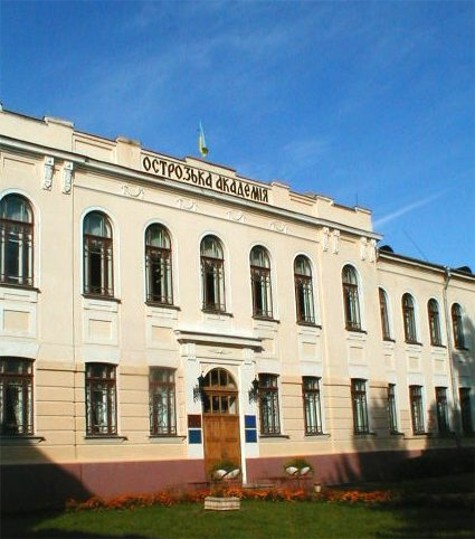National University of Ostroh Academy
National University of Ostroh Academy [Національний університет «Острозька Академія» or НаУОА; Natsionalnyi universytet Ostrozka Akademiia or NaUOA]. A self-governed research university located in the city of Ostroh, Rivne oblast, in the region of Volhynia in western Ukraine. Ostroh had been a site of a postsecondary school in the second half of the sixteenth century: the Ostroh Academy founded by Prince Kostiantyn Vasyl Ostrozky in 1576. The idea of reviving the Academy in independent Ukraine was first voiced in 1993 by a group of local intellectuals, among them the eminent historian Mykola P. Kovalsky who, for many years, had taught history of Ukraine at Dnipropetrovsk University. This idea was supported by then Vice Prime Minister (on issues of Humanitarian Policy) Mykola Zhulynsky and rector of the National University of Kyiv-Mohyla Academy Viacheslav Briukhovetsky. On 12 April 1994 Ostroh Collegium was officially established by the decree of President of Ukraine Leonid Kravchuk as a branch of the National University of Kyiv-Mohyla Academy (along with another branch in Mykolaiv; see Petro Mohyla Black Sea National University). In 1996 it was renamed into Ostroh Academy. In 2000 it was again reorganized into an independent institution of higher learning, granted the national university status, and assumed its present name. In 2009 it received the status of a self-governing research national institution of higher learning. Since 2010 NaUOA has been a member of the European Association of Universities. NaUOA’s founding rector is psychologist Ihor Pasichnyk.
NaUOA consists of six faculties: the humanities; Romance and Germanic languages; economics; law (Yoanykii Malynovsky Law Institute); political and information management; and international relations. In addition, there are a number of research and teaching institutes, centers, and laboratories, among them the Institute for Pre-College and Distance Learning; the Institute for the Study of the Ukrainian Diaspora (with its own specialized library); the Institute for Practical Psychology and Psychotherapy; the Center for Social Research; the Center for Political Research; the Center for the Study of the Princes of Ostroh; the Center for Jewish Studies; the Center for Islamic Studies (which, in 2019, began to publish Ukraine’s first scholarly periodical in Islamic studies Suchasne islamoznavstvo/Modern Islamic Studies Journal); and the Laboratory of Gender Studies. The Cultural and Art Center supervises the host of student artistic endeavors, including a theater, a choir, and a string ensemble, among others. The university publishes Naukovi zapysky NaOUA in several series: philosophy; economics; law; philology; psychology; and historical sciences. As of 2018 the NaOUA scholarly library consists of 550,000 volumes (of which 37,000 are periodicals), including old printed books from the 16th and 17th centuries.
NaUOA has been consistently ranked among the top tier of colleges and universities in Ukraine, particularly in the field of the humanities. In 2019 it was ranked 67/68 out of 240 in the Consolidated Ranking of all Ukrainian colleges and universities conducted by the influential educational web portal Osvita.ua. The same year it was also ranked 15 out of 224 in the ranking of Ukraine’s colleges and universities according to GPA of the applicants based on the External Independent Evaluation (ZNO) of secondary school graduates.
NaUOA’s campus includes buildings dating back to various historical periods. The oldest building on campus is the former Capuchin monastery (built in the mid-18th century). The newest building is the Scholarly Library built in 2006. The latest addition in the Ostroh city center, outside of campus, was completed in 2019.
BIBLIOGRAPHY
Ihor Pasichnyk, ed., Ostroz'ka akademiia: istoriia ta suchasnist' kul'turno-osvitnioho oseredku (Ostroh 2019)
NaUOA official web site: https://www.oa.edu.ua/
Serhiy Bilenky
[This article was written in 2020.]
.jpg)

